Accounting Fundamentals: Financial Reporting, Analysis, and Ratios
VerifiedAdded on 2023/01/06
|17
|3044
|36
Homework Assignment
AI Summary
This assignment comprehensively addresses key accounting principles, starting with journal entries, ledgers, and an updated trial balance. It progresses to the preparation of financial statements, including profit and loss statements and balance sheets, for two different businesses. The assignment fur...
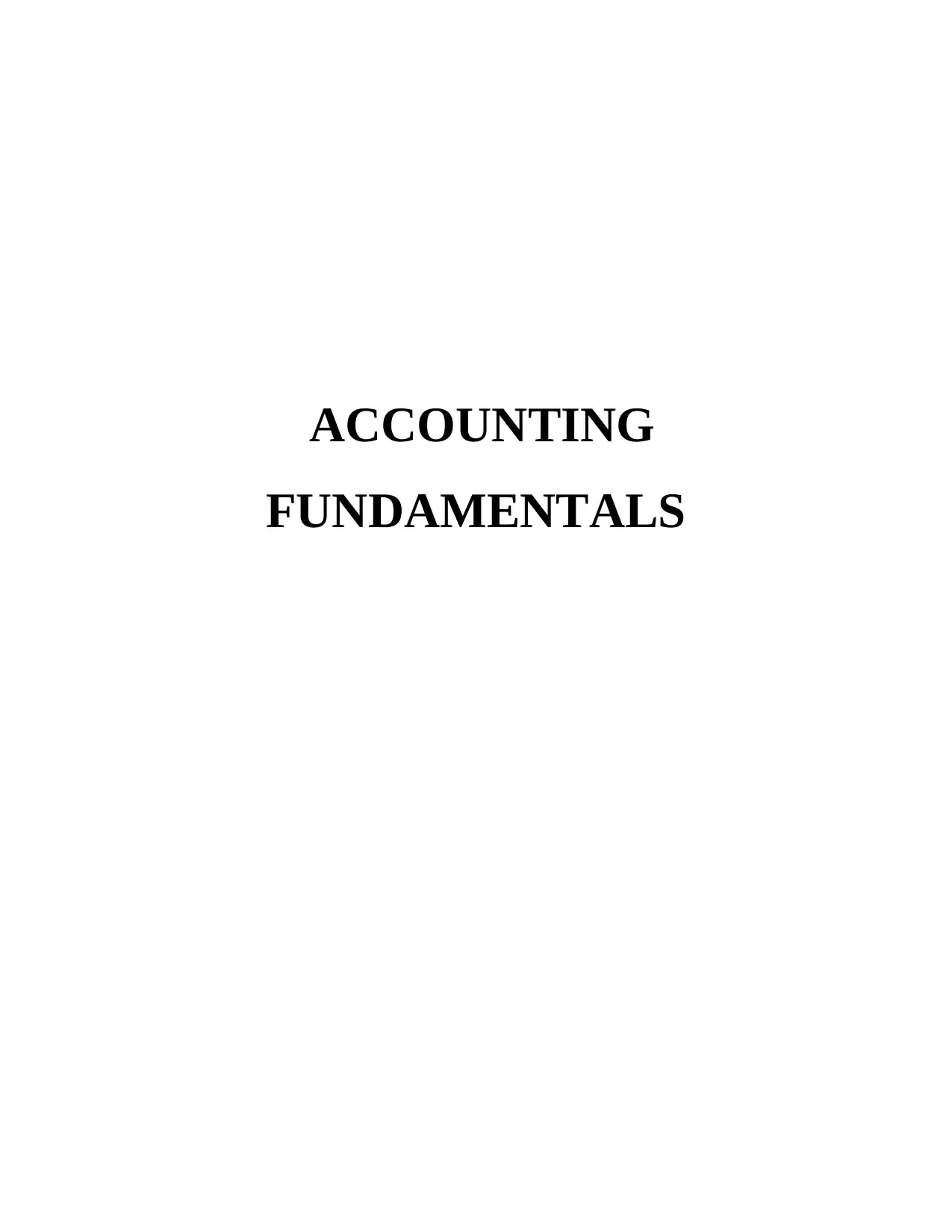
ACCOUNTING
FUNDAMENTALS
FUNDAMENTALS
Paraphrase This Document
Need a fresh take? Get an instant paraphrase of this document with our AI Paraphraser
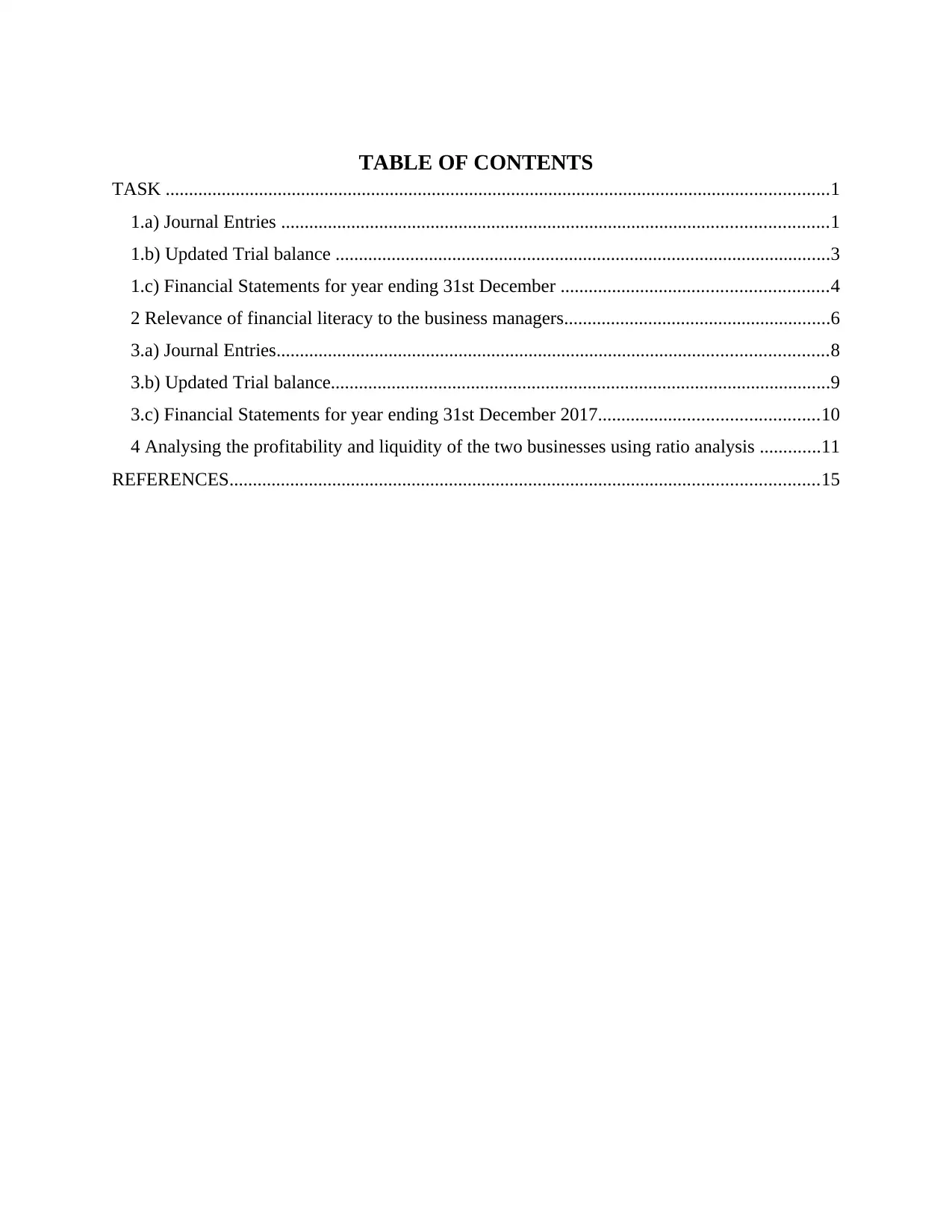
TABLE OF CONTENTS
TASK ..............................................................................................................................................1
1.a) Journal Entries .....................................................................................................................1
1.b) Updated Trial balance ..........................................................................................................3
1.c) Financial Statements for year ending 31st December .........................................................4
2 Relevance of financial literacy to the business managers.........................................................6
3.a) Journal Entries......................................................................................................................8
3.b) Updated Trial balance...........................................................................................................9
3.c) Financial Statements for year ending 31st December 2017...............................................10
4 Analysing the profitability and liquidity of the two businesses using ratio analysis .............11
REFERENCES..............................................................................................................................15
TASK ..............................................................................................................................................1
1.a) Journal Entries .....................................................................................................................1
1.b) Updated Trial balance ..........................................................................................................3
1.c) Financial Statements for year ending 31st December .........................................................4
2 Relevance of financial literacy to the business managers.........................................................6
3.a) Journal Entries......................................................................................................................8
3.b) Updated Trial balance...........................................................................................................9
3.c) Financial Statements for year ending 31st December 2017...............................................10
4 Analysing the profitability and liquidity of the two businesses using ratio analysis .............11
REFERENCES..............................................................................................................................15
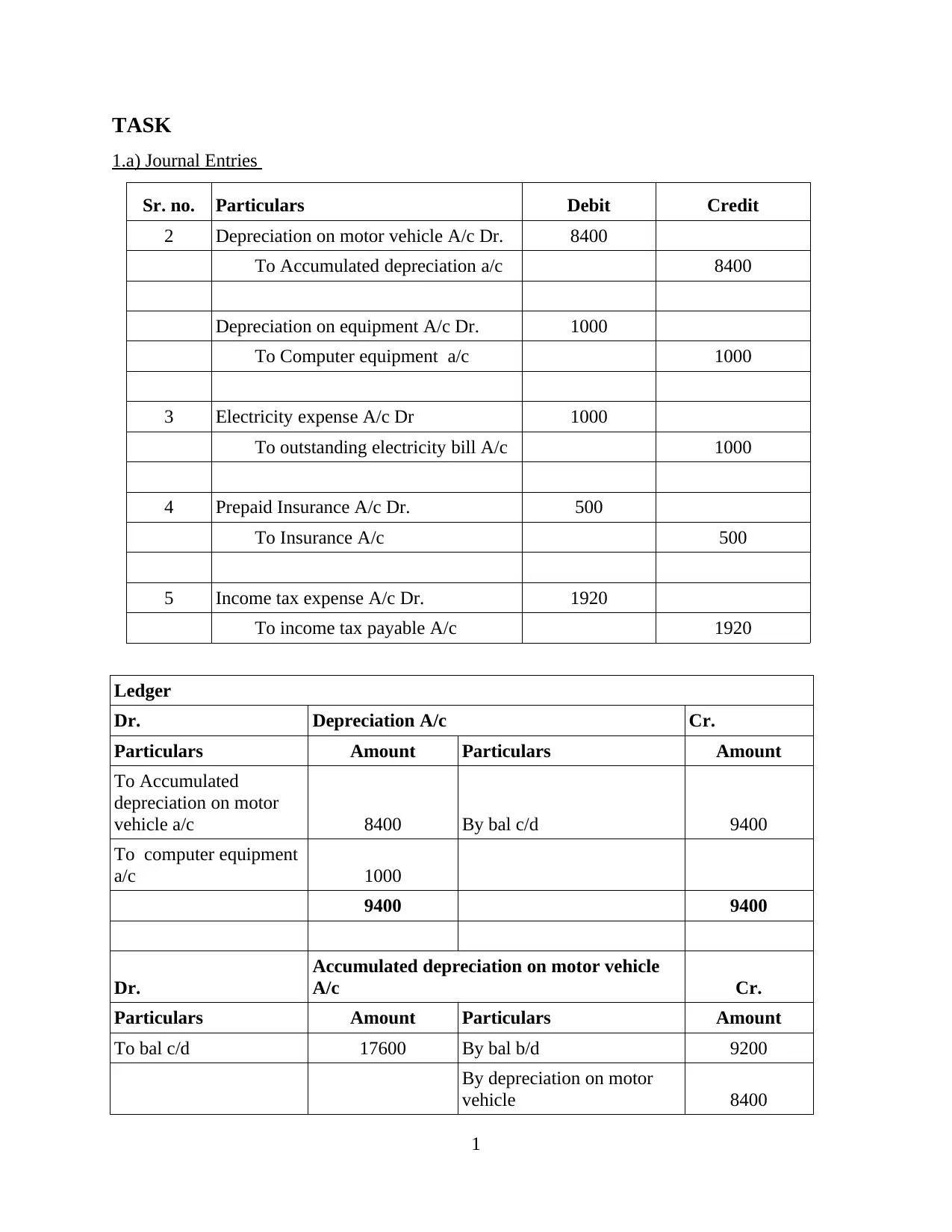
TASK
1.a) Journal Entries
Sr. no. Particulars Debit Credit
2 Depreciation on motor vehicle A/c Dr. 8400
To Accumulated depreciation a/c 8400
Depreciation on equipment A/c Dr. 1000
To Computer equipment a/c 1000
3 Electricity expense A/c Dr 1000
To outstanding electricity bill A/c 1000
4 Prepaid Insurance A/c Dr. 500
To Insurance A/c 500
5 Income tax expense A/c Dr. 1920
To income tax payable A/c 1920
Ledger
Dr. Depreciation A/c Cr.
Particulars Amount Particulars Amount
To Accumulated
depreciation on motor
vehicle a/c 8400 By bal c/d 9400
To computer equipment
a/c 1000
9400 9400
Dr.
Accumulated depreciation on motor vehicle
A/c Cr.
Particulars Amount Particulars Amount
To bal c/d 17600 By bal b/d 9200
By depreciation on motor
vehicle 8400
1
1.a) Journal Entries
Sr. no. Particulars Debit Credit
2 Depreciation on motor vehicle A/c Dr. 8400
To Accumulated depreciation a/c 8400
Depreciation on equipment A/c Dr. 1000
To Computer equipment a/c 1000
3 Electricity expense A/c Dr 1000
To outstanding electricity bill A/c 1000
4 Prepaid Insurance A/c Dr. 500
To Insurance A/c 500
5 Income tax expense A/c Dr. 1920
To income tax payable A/c 1920
Ledger
Dr. Depreciation A/c Cr.
Particulars Amount Particulars Amount
To Accumulated
depreciation on motor
vehicle a/c 8400 By bal c/d 9400
To computer equipment
a/c 1000
9400 9400
Dr.
Accumulated depreciation on motor vehicle
A/c Cr.
Particulars Amount Particulars Amount
To bal c/d 17600 By bal b/d 9200
By depreciation on motor
vehicle 8400
1
⊘ This is a preview!⊘
Do you want full access?
Subscribe today to unlock all pages.

Trusted by 1+ million students worldwide

17600 17600
Dr. Computer Equipment Cr.
Particulars Amount Particulars Amount
To bal b/d 10000
By depreciation on computer
equipment 1000
By bal C/d 9000
10000 10000
Dr. Electricity expense A/c Cr.
Particulars Amount Particulars Amount
To bal b/d 7000 To bal c/d 8000
To outstanding telephone
bill 1000
8000 8000
Dr. Outstanding electricity bill A/c Cr.
Particulars Amount Particulars Amount
To bal c/d 1000 By electricity expense 1000
1000 1000
Dr. Prepaid insurance A/c Cr.
Particulars Amount Particulars Amount
To insurance 500 By bal c/d 500
500 500
Dr. Insurance A/c Cr.
Particulars Amount Particulars Amount
To bal b/d 1500 By prepaid insurance 500
By bal c/d 1000
1500 1500
2
Dr. Computer Equipment Cr.
Particulars Amount Particulars Amount
To bal b/d 10000
By depreciation on computer
equipment 1000
By bal C/d 9000
10000 10000
Dr. Electricity expense A/c Cr.
Particulars Amount Particulars Amount
To bal b/d 7000 To bal c/d 8000
To outstanding telephone
bill 1000
8000 8000
Dr. Outstanding electricity bill A/c Cr.
Particulars Amount Particulars Amount
To bal c/d 1000 By electricity expense 1000
1000 1000
Dr. Prepaid insurance A/c Cr.
Particulars Amount Particulars Amount
To insurance 500 By bal c/d 500
500 500
Dr. Insurance A/c Cr.
Particulars Amount Particulars Amount
To bal b/d 1500 By prepaid insurance 500
By bal c/d 1000
1500 1500
2
Paraphrase This Document
Need a fresh take? Get an instant paraphrase of this document with our AI Paraphraser
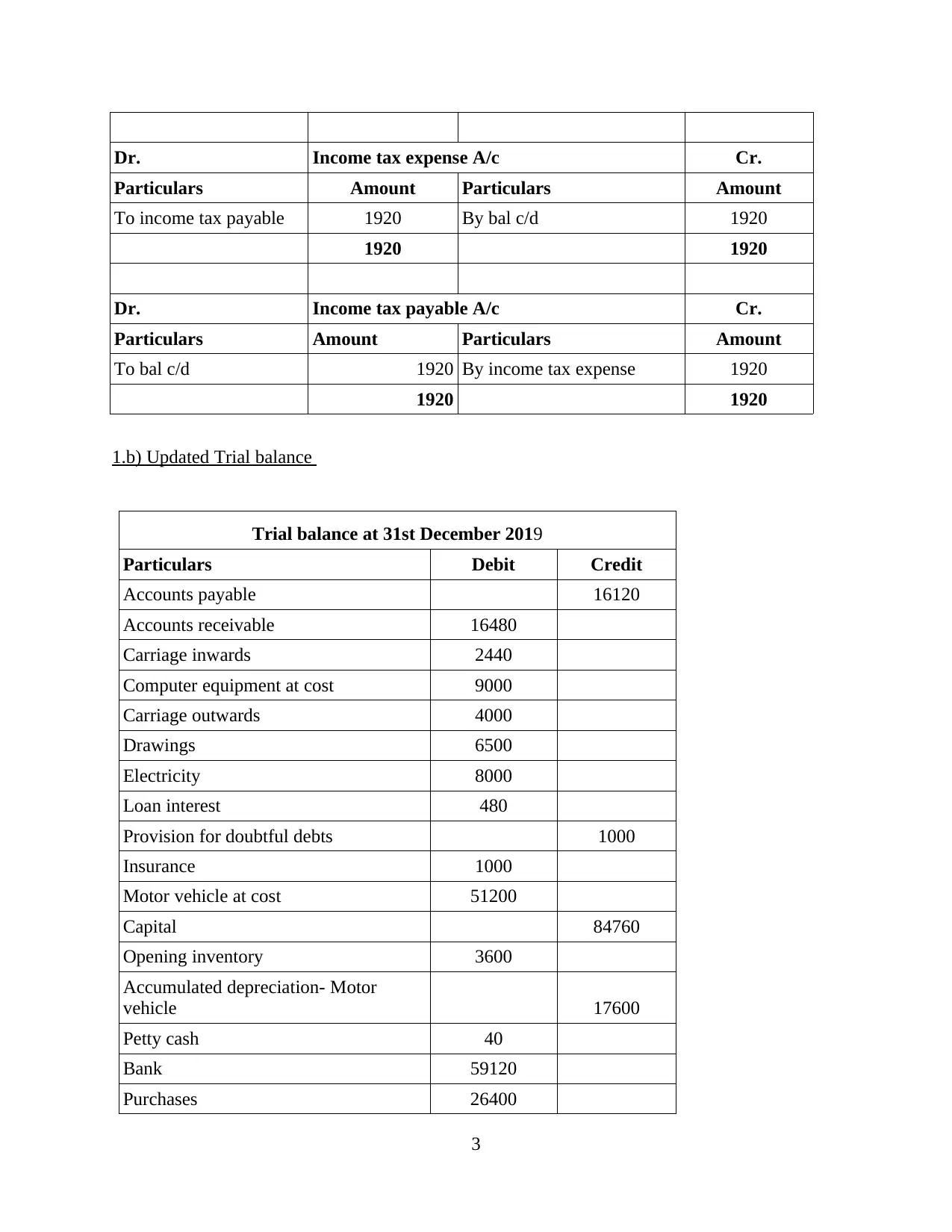
Dr. Income tax expense A/c Cr.
Particulars Amount Particulars Amount
To income tax payable 1920 By bal c/d 1920
1920 1920
Dr. Income tax payable A/c Cr.
Particulars Amount Particulars Amount
To bal c/d 1920 By income tax expense 1920
1920 1920
1.b) Updated Trial balance
Trial balance at 31st December 2019
Particulars Debit Credit
Accounts payable 16120
Accounts receivable 16480
Carriage inwards 2440
Computer equipment at cost 9000
Carriage outwards 4000
Drawings 6500
Electricity 8000
Loan interest 480
Provision for doubtful debts 1000
Insurance 1000
Motor vehicle at cost 51200
Capital 84760
Opening inventory 3600
Accumulated depreciation- Motor
vehicle 17600
Petty cash 40
Bank 59120
Purchases 26400
3
Particulars Amount Particulars Amount
To income tax payable 1920 By bal c/d 1920
1920 1920
Dr. Income tax payable A/c Cr.
Particulars Amount Particulars Amount
To bal c/d 1920 By income tax expense 1920
1920 1920
1.b) Updated Trial balance
Trial balance at 31st December 2019
Particulars Debit Credit
Accounts payable 16120
Accounts receivable 16480
Carriage inwards 2440
Computer equipment at cost 9000
Carriage outwards 4000
Drawings 6500
Electricity 8000
Loan interest 480
Provision for doubtful debts 1000
Insurance 1000
Motor vehicle at cost 51200
Capital 84760
Opening inventory 3600
Accumulated depreciation- Motor
vehicle 17600
Petty cash 40
Bank 59120
Purchases 26400
3
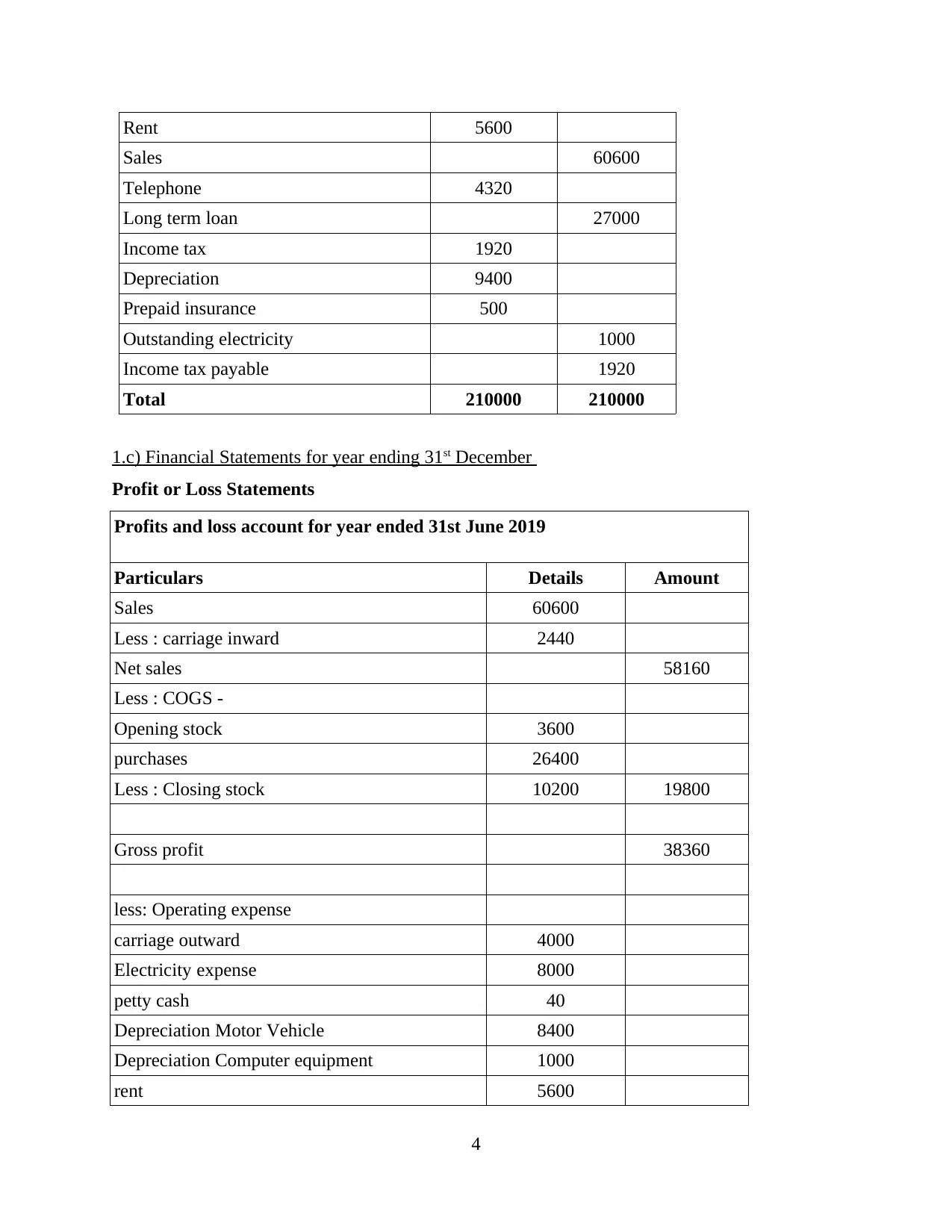
Rent 5600
Sales 60600
Telephone 4320
Long term loan 27000
Income tax 1920
Depreciation 9400
Prepaid insurance 500
Outstanding electricity 1000
Income tax payable 1920
Total 210000 210000
1.c) Financial Statements for year ending 31st December
Profit or Loss Statements
Profits and loss account for year ended 31st June 2019
Particulars Details Amount
Sales 60600
Less : carriage inward 2440
Net sales 58160
Less : COGS -
Opening stock 3600
purchases 26400
Less : Closing stock 10200 19800
Gross profit 38360
less: Operating expense
carriage outward 4000
Electricity expense 8000
petty cash 40
Depreciation Motor Vehicle 8400
Depreciation Computer equipment 1000
rent 5600
4
Sales 60600
Telephone 4320
Long term loan 27000
Income tax 1920
Depreciation 9400
Prepaid insurance 500
Outstanding electricity 1000
Income tax payable 1920
Total 210000 210000
1.c) Financial Statements for year ending 31st December
Profit or Loss Statements
Profits and loss account for year ended 31st June 2019
Particulars Details Amount
Sales 60600
Less : carriage inward 2440
Net sales 58160
Less : COGS -
Opening stock 3600
purchases 26400
Less : Closing stock 10200 19800
Gross profit 38360
less: Operating expense
carriage outward 4000
Electricity expense 8000
petty cash 40
Depreciation Motor Vehicle 8400
Depreciation Computer equipment 1000
rent 5600
4
⊘ This is a preview!⊘
Do you want full access?
Subscribe today to unlock all pages.

Trusted by 1+ million students worldwide

Insurance 1000
telephone 4320 32360
Operating profit 6000
less: interest expense 480
Profit before tax 5520
Less : income tax 1920
Net profit 3600
Balance Sheet
Balance sheet at year ended 31st June 2019
Particulars Details Amount
Owner's Equity
Capital 84760
add: profits 3600
less: drawings 6500
81860
Liabilities
Current liability
Accounts payable 16120
Outstanding electricity bill 1000
Income tax payable 1920
Accumulated depreciation- Motor vehicle 17600
36640
Non-current liability
Long term loan 27000
Provision for doubtful debts 1000 28000
Total Equity & Liabilities 146500
Fixed assets:
Computer equipment 9000
Motor vehicle 51200 60200
5
telephone 4320 32360
Operating profit 6000
less: interest expense 480
Profit before tax 5520
Less : income tax 1920
Net profit 3600
Balance Sheet
Balance sheet at year ended 31st June 2019
Particulars Details Amount
Owner's Equity
Capital 84760
add: profits 3600
less: drawings 6500
81860
Liabilities
Current liability
Accounts payable 16120
Outstanding electricity bill 1000
Income tax payable 1920
Accumulated depreciation- Motor vehicle 17600
36640
Non-current liability
Long term loan 27000
Provision for doubtful debts 1000 28000
Total Equity & Liabilities 146500
Fixed assets:
Computer equipment 9000
Motor vehicle 51200 60200
5
Paraphrase This Document
Need a fresh take? Get an instant paraphrase of this document with our AI Paraphraser
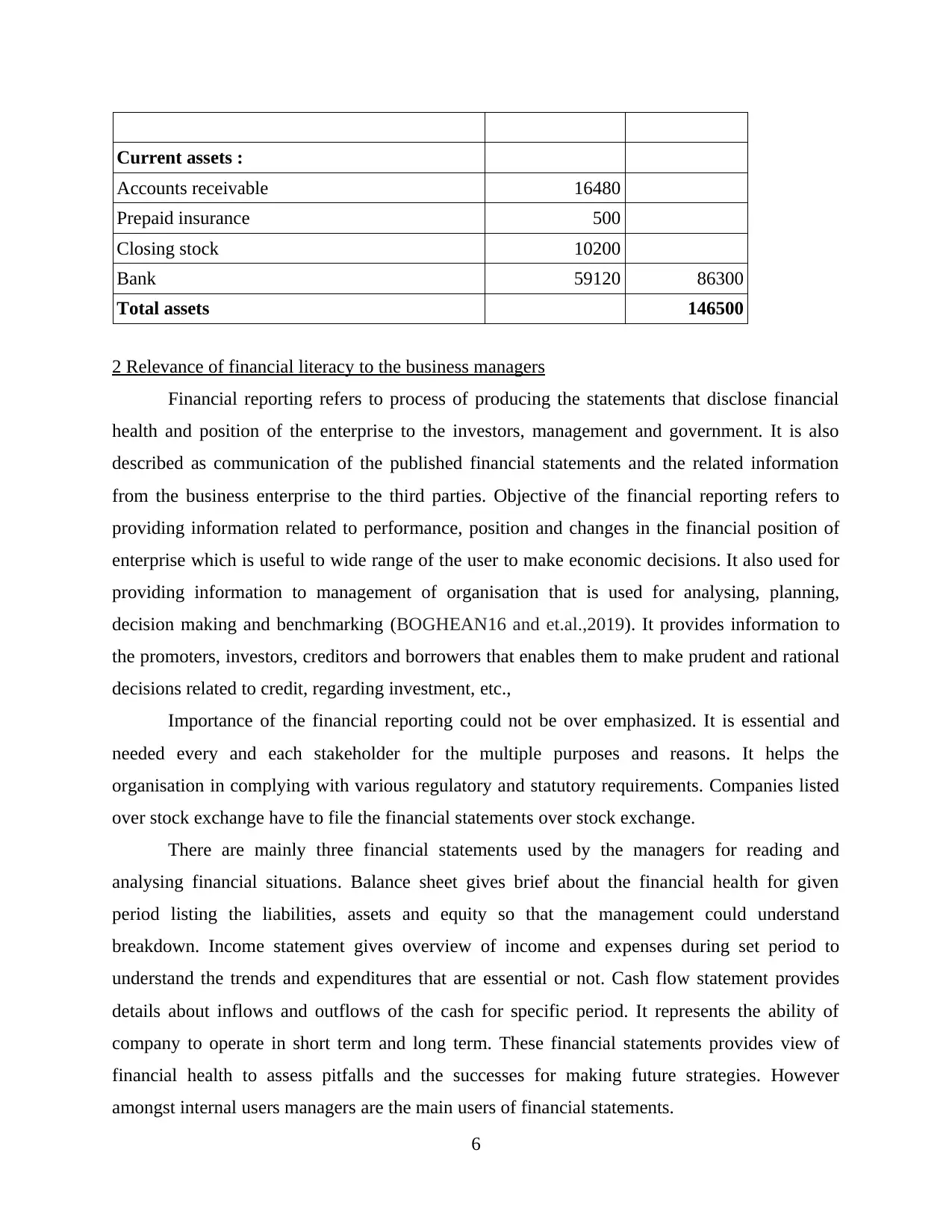
Current assets :
Accounts receivable 16480
Prepaid insurance 500
Closing stock 10200
Bank 59120 86300
Total assets 146500
2 Relevance of financial literacy to the business managers
Financial reporting refers to process of producing the statements that disclose financial
health and position of the enterprise to the investors, management and government. It is also
described as communication of the published financial statements and the related information
from the business enterprise to the third parties. Objective of the financial reporting refers to
providing information related to performance, position and changes in the financial position of
enterprise which is useful to wide range of the user to make economic decisions. It also used for
providing information to management of organisation that is used for analysing, planning,
decision making and benchmarking (BOGHEAN16 and et.al.,2019). It provides information to
the promoters, investors, creditors and borrowers that enables them to make prudent and rational
decisions related to credit, regarding investment, etc.,
Importance of the financial reporting could not be over emphasized. It is essential and
needed every and each stakeholder for the multiple purposes and reasons. It helps the
organisation in complying with various regulatory and statutory requirements. Companies listed
over stock exchange have to file the financial statements over stock exchange.
There are mainly three financial statements used by the managers for reading and
analysing financial situations. Balance sheet gives brief about the financial health for given
period listing the liabilities, assets and equity so that the management could understand
breakdown. Income statement gives overview of income and expenses during set period to
understand the trends and expenditures that are essential or not. Cash flow statement provides
details about inflows and outflows of the cash for specific period. It represents the ability of
company to operate in short term and long term. These financial statements provides view of
financial health to assess pitfalls and the successes for making future strategies. However
amongst internal users managers are the main users of financial statements.
6
Accounts receivable 16480
Prepaid insurance 500
Closing stock 10200
Bank 59120 86300
Total assets 146500
2 Relevance of financial literacy to the business managers
Financial reporting refers to process of producing the statements that disclose financial
health and position of the enterprise to the investors, management and government. It is also
described as communication of the published financial statements and the related information
from the business enterprise to the third parties. Objective of the financial reporting refers to
providing information related to performance, position and changes in the financial position of
enterprise which is useful to wide range of the user to make economic decisions. It also used for
providing information to management of organisation that is used for analysing, planning,
decision making and benchmarking (BOGHEAN16 and et.al.,2019). It provides information to
the promoters, investors, creditors and borrowers that enables them to make prudent and rational
decisions related to credit, regarding investment, etc.,
Importance of the financial reporting could not be over emphasized. It is essential and
needed every and each stakeholder for the multiple purposes and reasons. It helps the
organisation in complying with various regulatory and statutory requirements. Companies listed
over stock exchange have to file the financial statements over stock exchange.
There are mainly three financial statements used by the managers for reading and
analysing financial situations. Balance sheet gives brief about the financial health for given
period listing the liabilities, assets and equity so that the management could understand
breakdown. Income statement gives overview of income and expenses during set period to
understand the trends and expenditures that are essential or not. Cash flow statement provides
details about inflows and outflows of the cash for specific period. It represents the ability of
company to operate in short term and long term. These financial statements provides view of
financial health to assess pitfalls and the successes for making future strategies. However
amongst internal users managers are the main users of financial statements.
6
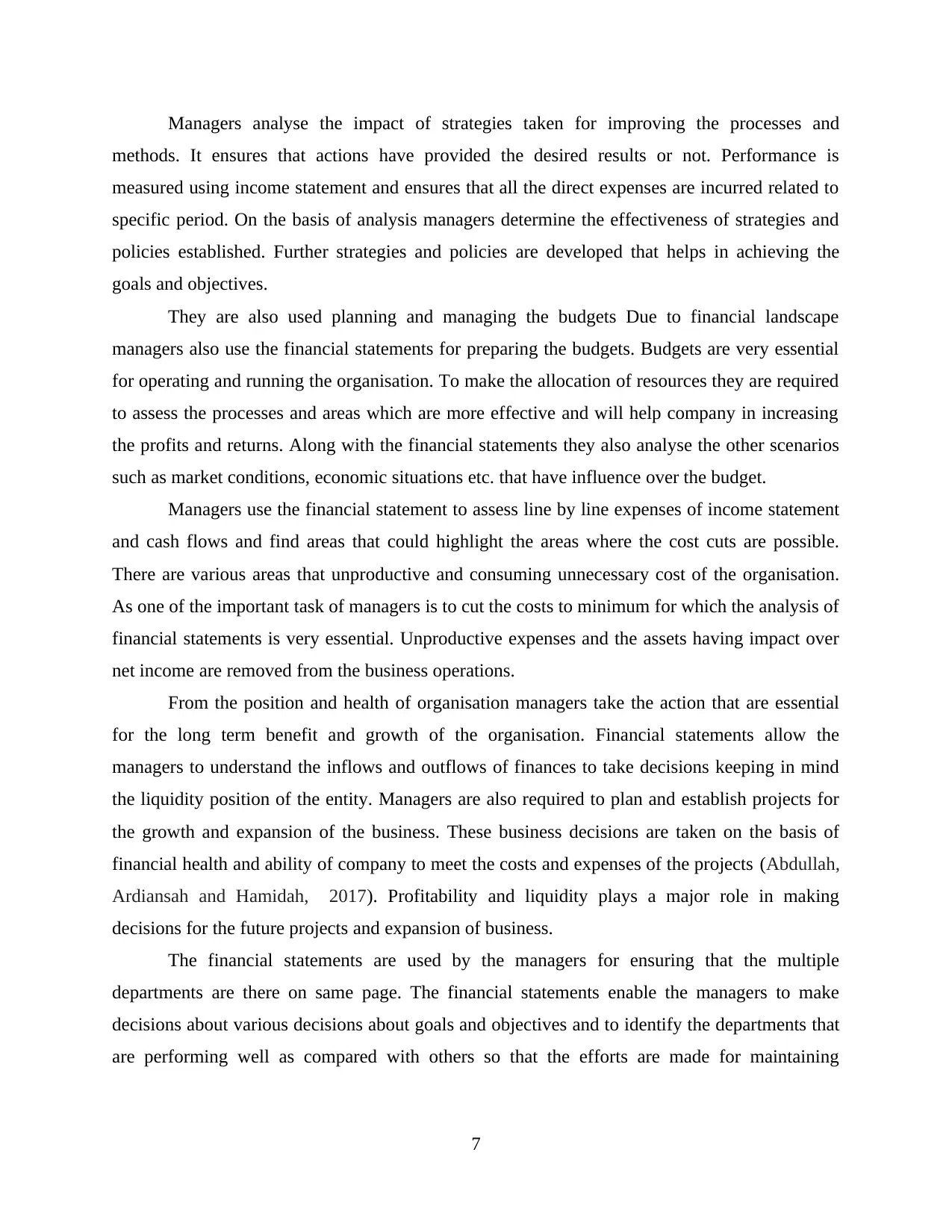
Managers analyse the impact of strategies taken for improving the processes and
methods. It ensures that actions have provided the desired results or not. Performance is
measured using income statement and ensures that all the direct expenses are incurred related to
specific period. On the basis of analysis managers determine the effectiveness of strategies and
policies established. Further strategies and policies are developed that helps in achieving the
goals and objectives.
They are also used planning and managing the budgets Due to financial landscape
managers also use the financial statements for preparing the budgets. Budgets are very essential
for operating and running the organisation. To make the allocation of resources they are required
to assess the processes and areas which are more effective and will help company in increasing
the profits and returns. Along with the financial statements they also analyse the other scenarios
such as market conditions, economic situations etc. that have influence over the budget.
Managers use the financial statement to assess line by line expenses of income statement
and cash flows and find areas that could highlight the areas where the cost cuts are possible.
There are various areas that unproductive and consuming unnecessary cost of the organisation.
As one of the important task of managers is to cut the costs to minimum for which the analysis of
financial statements is very essential. Unproductive expenses and the assets having impact over
net income are removed from the business operations.
From the position and health of organisation managers take the action that are essential
for the long term benefit and growth of the organisation. Financial statements allow the
managers to understand the inflows and outflows of finances to take decisions keeping in mind
the liquidity position of the entity. Managers are also required to plan and establish projects for
the growth and expansion of the business. These business decisions are taken on the basis of
financial health and ability of company to meet the costs and expenses of the projects (Abdullah,
Ardiansah and Hamidah, 2017). Profitability and liquidity plays a major role in making
decisions for the future projects and expansion of business.
The financial statements are used by the managers for ensuring that the multiple
departments are there on same page. The financial statements enable the managers to make
decisions about various decisions about goals and objectives and to identify the departments that
are performing well as compared with others so that the efforts are made for maintaining
7
methods. It ensures that actions have provided the desired results or not. Performance is
measured using income statement and ensures that all the direct expenses are incurred related to
specific period. On the basis of analysis managers determine the effectiveness of strategies and
policies established. Further strategies and policies are developed that helps in achieving the
goals and objectives.
They are also used planning and managing the budgets Due to financial landscape
managers also use the financial statements for preparing the budgets. Budgets are very essential
for operating and running the organisation. To make the allocation of resources they are required
to assess the processes and areas which are more effective and will help company in increasing
the profits and returns. Along with the financial statements they also analyse the other scenarios
such as market conditions, economic situations etc. that have influence over the budget.
Managers use the financial statement to assess line by line expenses of income statement
and cash flows and find areas that could highlight the areas where the cost cuts are possible.
There are various areas that unproductive and consuming unnecessary cost of the organisation.
As one of the important task of managers is to cut the costs to minimum for which the analysis of
financial statements is very essential. Unproductive expenses and the assets having impact over
net income are removed from the business operations.
From the position and health of organisation managers take the action that are essential
for the long term benefit and growth of the organisation. Financial statements allow the
managers to understand the inflows and outflows of finances to take decisions keeping in mind
the liquidity position of the entity. Managers are also required to plan and establish projects for
the growth and expansion of the business. These business decisions are taken on the basis of
financial health and ability of company to meet the costs and expenses of the projects (Abdullah,
Ardiansah and Hamidah, 2017). Profitability and liquidity plays a major role in making
decisions for the future projects and expansion of business.
The financial statements are used by the managers for ensuring that the multiple
departments are there on same page. The financial statements enable the managers to make
decisions about various decisions about goals and objectives and to identify the departments that
are performing well as compared with others so that the efforts are made for maintaining
7
⊘ This is a preview!⊘
Do you want full access?
Subscribe today to unlock all pages.

Trusted by 1+ million students worldwide
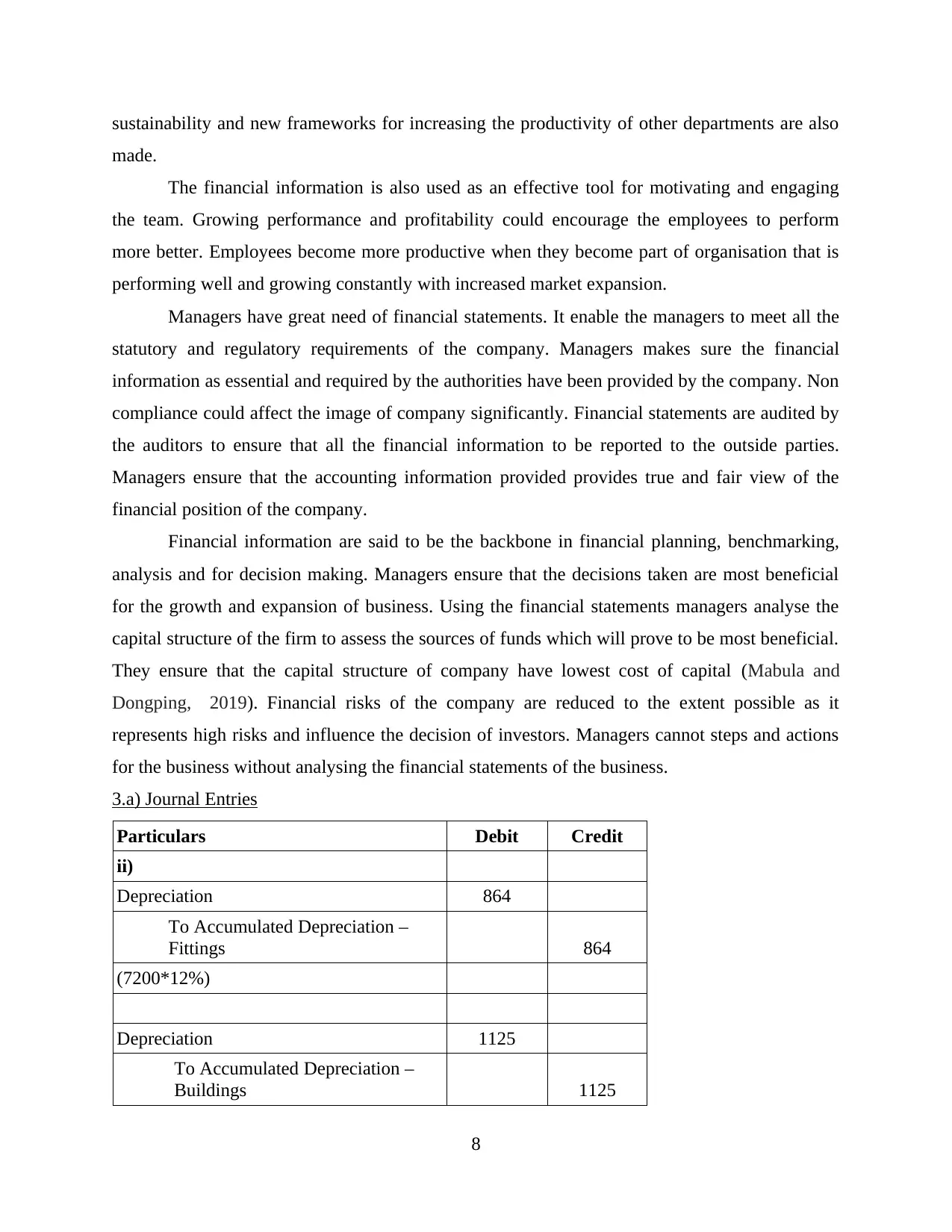
sustainability and new frameworks for increasing the productivity of other departments are also
made.
The financial information is also used as an effective tool for motivating and engaging
the team. Growing performance and profitability could encourage the employees to perform
more better. Employees become more productive when they become part of organisation that is
performing well and growing constantly with increased market expansion.
Managers have great need of financial statements. It enable the managers to meet all the
statutory and regulatory requirements of the company. Managers makes sure the financial
information as essential and required by the authorities have been provided by the company. Non
compliance could affect the image of company significantly. Financial statements are audited by
the auditors to ensure that all the financial information to be reported to the outside parties.
Managers ensure that the accounting information provided provides true and fair view of the
financial position of the company.
Financial information are said to be the backbone in financial planning, benchmarking,
analysis and for decision making. Managers ensure that the decisions taken are most beneficial
for the growth and expansion of business. Using the financial statements managers analyse the
capital structure of the firm to assess the sources of funds which will prove to be most beneficial.
They ensure that the capital structure of company have lowest cost of capital (Mabula and
Dongping, 2019). Financial risks of the company are reduced to the extent possible as it
represents high risks and influence the decision of investors. Managers cannot steps and actions
for the business without analysing the financial statements of the business.
3.a) Journal Entries
Particulars Debit Credit
ii)
Depreciation 864
To Accumulated Depreciation –
Fittings 864
(7200*12%)
Depreciation 1125
To Accumulated Depreciation –
Buildings 1125
8
made.
The financial information is also used as an effective tool for motivating and engaging
the team. Growing performance and profitability could encourage the employees to perform
more better. Employees become more productive when they become part of organisation that is
performing well and growing constantly with increased market expansion.
Managers have great need of financial statements. It enable the managers to meet all the
statutory and regulatory requirements of the company. Managers makes sure the financial
information as essential and required by the authorities have been provided by the company. Non
compliance could affect the image of company significantly. Financial statements are audited by
the auditors to ensure that all the financial information to be reported to the outside parties.
Managers ensure that the accounting information provided provides true and fair view of the
financial position of the company.
Financial information are said to be the backbone in financial planning, benchmarking,
analysis and for decision making. Managers ensure that the decisions taken are most beneficial
for the growth and expansion of business. Using the financial statements managers analyse the
capital structure of the firm to assess the sources of funds which will prove to be most beneficial.
They ensure that the capital structure of company have lowest cost of capital (Mabula and
Dongping, 2019). Financial risks of the company are reduced to the extent possible as it
represents high risks and influence the decision of investors. Managers cannot steps and actions
for the business without analysing the financial statements of the business.
3.a) Journal Entries
Particulars Debit Credit
ii)
Depreciation 864
To Accumulated Depreciation –
Fittings 864
(7200*12%)
Depreciation 1125
To Accumulated Depreciation –
Buildings 1125
8
Paraphrase This Document
Need a fresh take? Get an instant paraphrase of this document with our AI Paraphraser
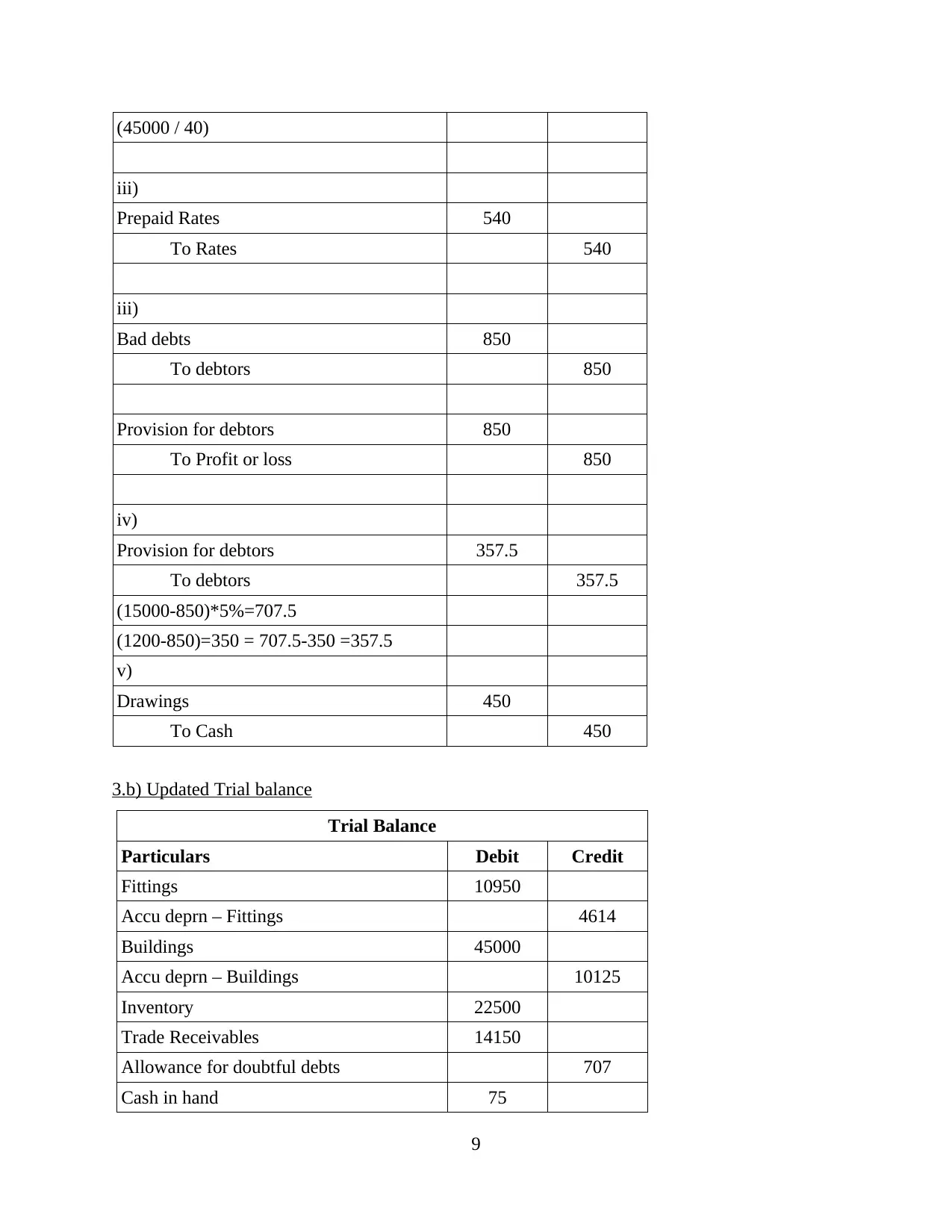
(45000 / 40)
iii)
Prepaid Rates 540
To Rates 540
iii)
Bad debts 850
To debtors 850
Provision for debtors 850
To Profit or loss 850
iv)
Provision for debtors 357.5
To debtors 357.5
(15000-850)*5%=707.5
(1200-850)=350 = 707.5-350 =357.5
v)
Drawings 450
To Cash 450
3.b) Updated Trial balance
Trial Balance
Particulars Debit Credit
Fittings 10950
Accu deprn – Fittings 4614
Buildings 45000
Accu deprn – Buildings 10125
Inventory 22500
Trade Receivables 14150
Allowance for doubtful debts 707
Cash in hand 75
9
iii)
Prepaid Rates 540
To Rates 540
iii)
Bad debts 850
To debtors 850
Provision for debtors 850
To Profit or loss 850
iv)
Provision for debtors 357.5
To debtors 357.5
(15000-850)*5%=707.5
(1200-850)=350 = 707.5-350 =357.5
v)
Drawings 450
To Cash 450
3.b) Updated Trial balance
Trial Balance
Particulars Debit Credit
Fittings 10950
Accu deprn – Fittings 4614
Buildings 45000
Accu deprn – Buildings 10125
Inventory 22500
Trade Receivables 14150
Allowance for doubtful debts 707
Cash in hand 75
9
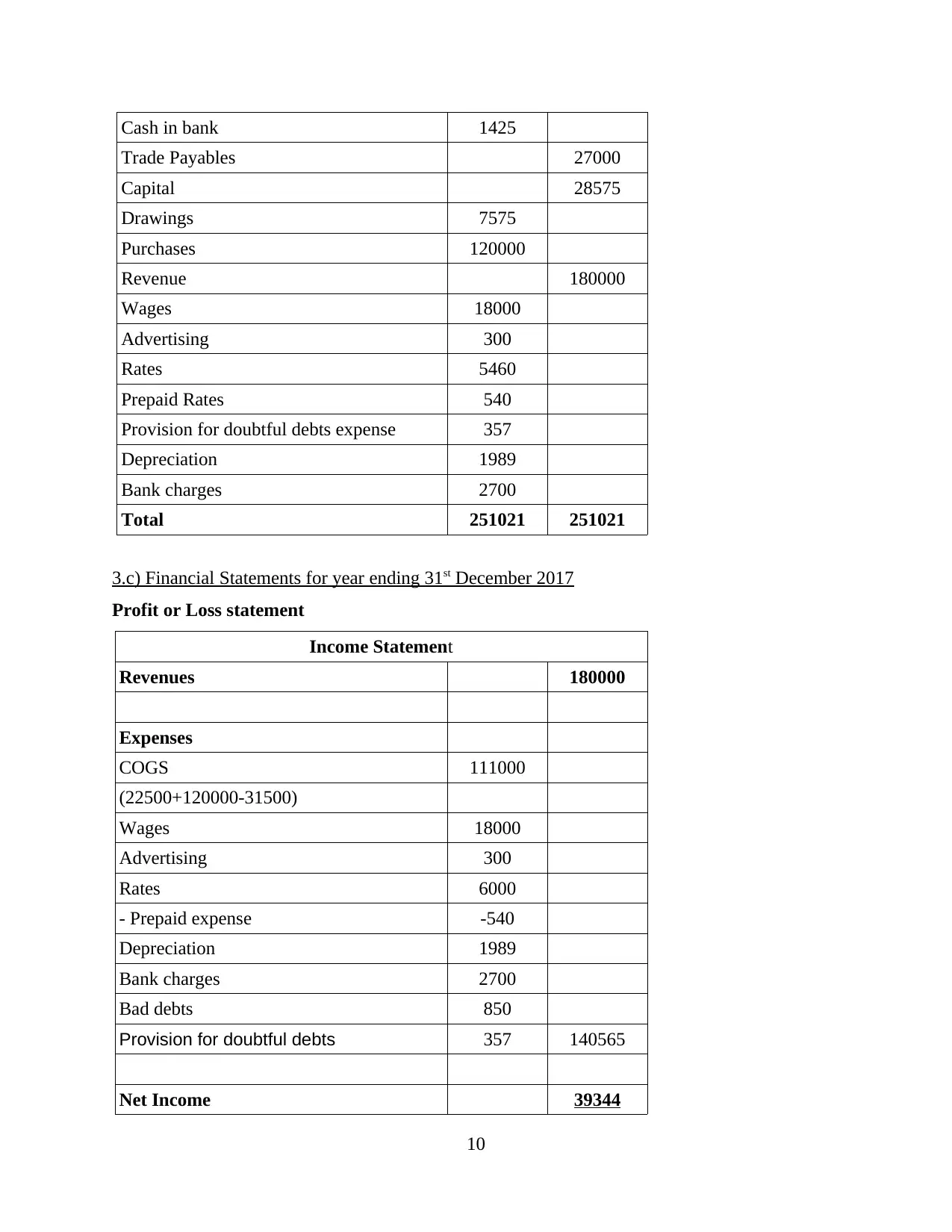
Cash in bank 1425
Trade Payables 27000
Capital 28575
Drawings 7575
Purchases 120000
Revenue 180000
Wages 18000
Advertising 300
Rates 5460
Prepaid Rates 540
Provision for doubtful debts expense 357
Depreciation 1989
Bank charges 2700
Total 251021 251021
3.c) Financial Statements for year ending 31st December 2017
Profit or Loss statement
Income Statement
Revenues 180000
Expenses
COGS 111000
(22500+120000-31500)
Wages 18000
Advertising 300
Rates 6000
- Prepaid expense -540
Depreciation 1989
Bank charges 2700
Bad debts 850
Provision for doubtful debts 357 140565
Net Income 39344
10
Trade Payables 27000
Capital 28575
Drawings 7575
Purchases 120000
Revenue 180000
Wages 18000
Advertising 300
Rates 5460
Prepaid Rates 540
Provision for doubtful debts expense 357
Depreciation 1989
Bank charges 2700
Total 251021 251021
3.c) Financial Statements for year ending 31st December 2017
Profit or Loss statement
Income Statement
Revenues 180000
Expenses
COGS 111000
(22500+120000-31500)
Wages 18000
Advertising 300
Rates 6000
- Prepaid expense -540
Depreciation 1989
Bank charges 2700
Bad debts 850
Provision for doubtful debts 357 140565
Net Income 39344
10
⊘ This is a preview!⊘
Do you want full access?
Subscribe today to unlock all pages.

Trusted by 1+ million students worldwide
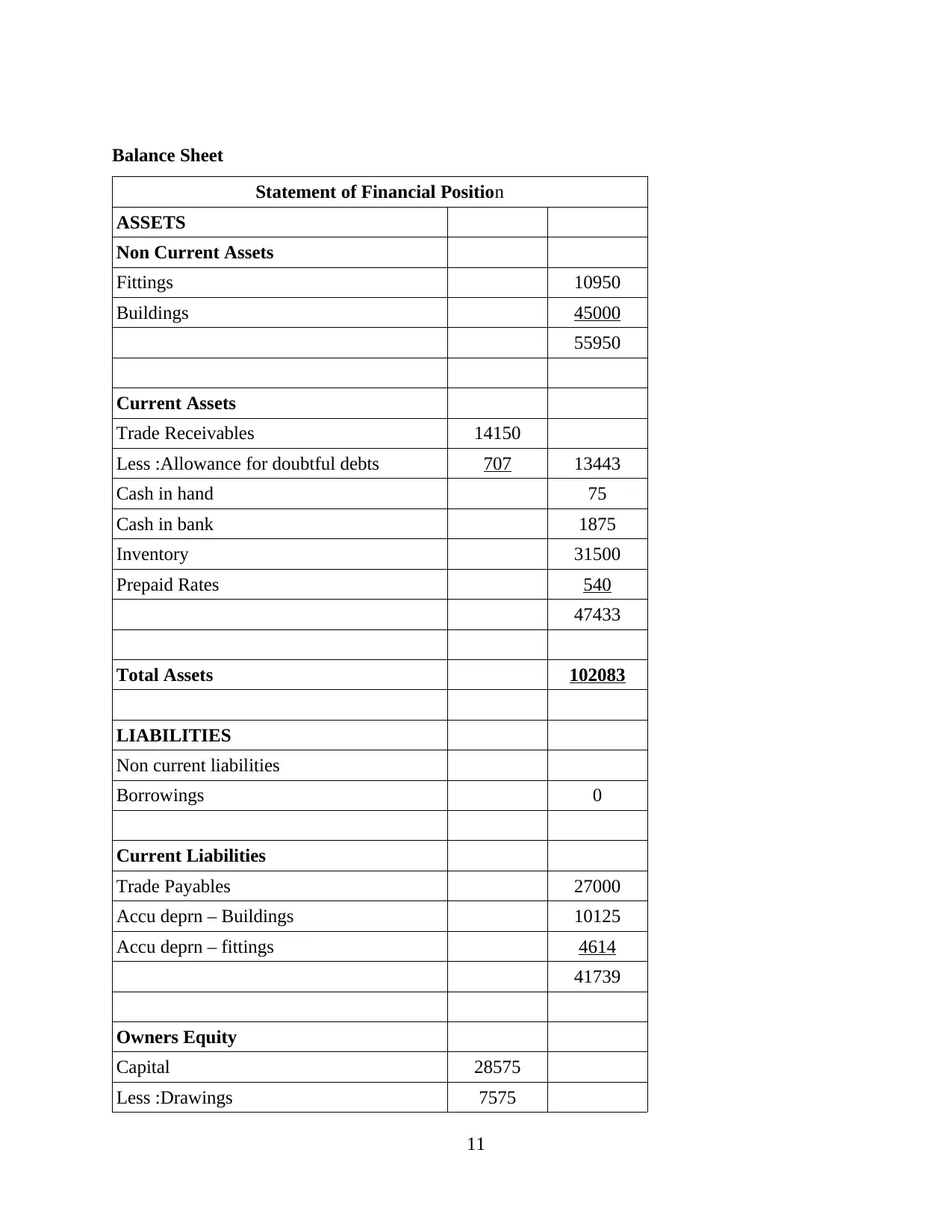
Balance Sheet
Statement of Financial Position
ASSETS
Non Current Assets
Fittings 10950
Buildings 45000
55950
Current Assets
Trade Receivables 14150
Less :Allowance for doubtful debts 707 13443
Cash in hand 75
Cash in bank 1875
Inventory 31500
Prepaid Rates 540
47433
Total Assets 102083
LIABILITIES
Non current liabilities
Borrowings 0
Current Liabilities
Trade Payables 27000
Accu deprn – Buildings 10125
Accu deprn – fittings 4614
41739
Owners Equity
Capital 28575
Less :Drawings 7575
11
Statement of Financial Position
ASSETS
Non Current Assets
Fittings 10950
Buildings 45000
55950
Current Assets
Trade Receivables 14150
Less :Allowance for doubtful debts 707 13443
Cash in hand 75
Cash in bank 1875
Inventory 31500
Prepaid Rates 540
47433
Total Assets 102083
LIABILITIES
Non current liabilities
Borrowings 0
Current Liabilities
Trade Payables 27000
Accu deprn – Buildings 10125
Accu deprn – fittings 4614
41739
Owners Equity
Capital 28575
Less :Drawings 7575
11
Paraphrase This Document
Need a fresh take? Get an instant paraphrase of this document with our AI Paraphraser
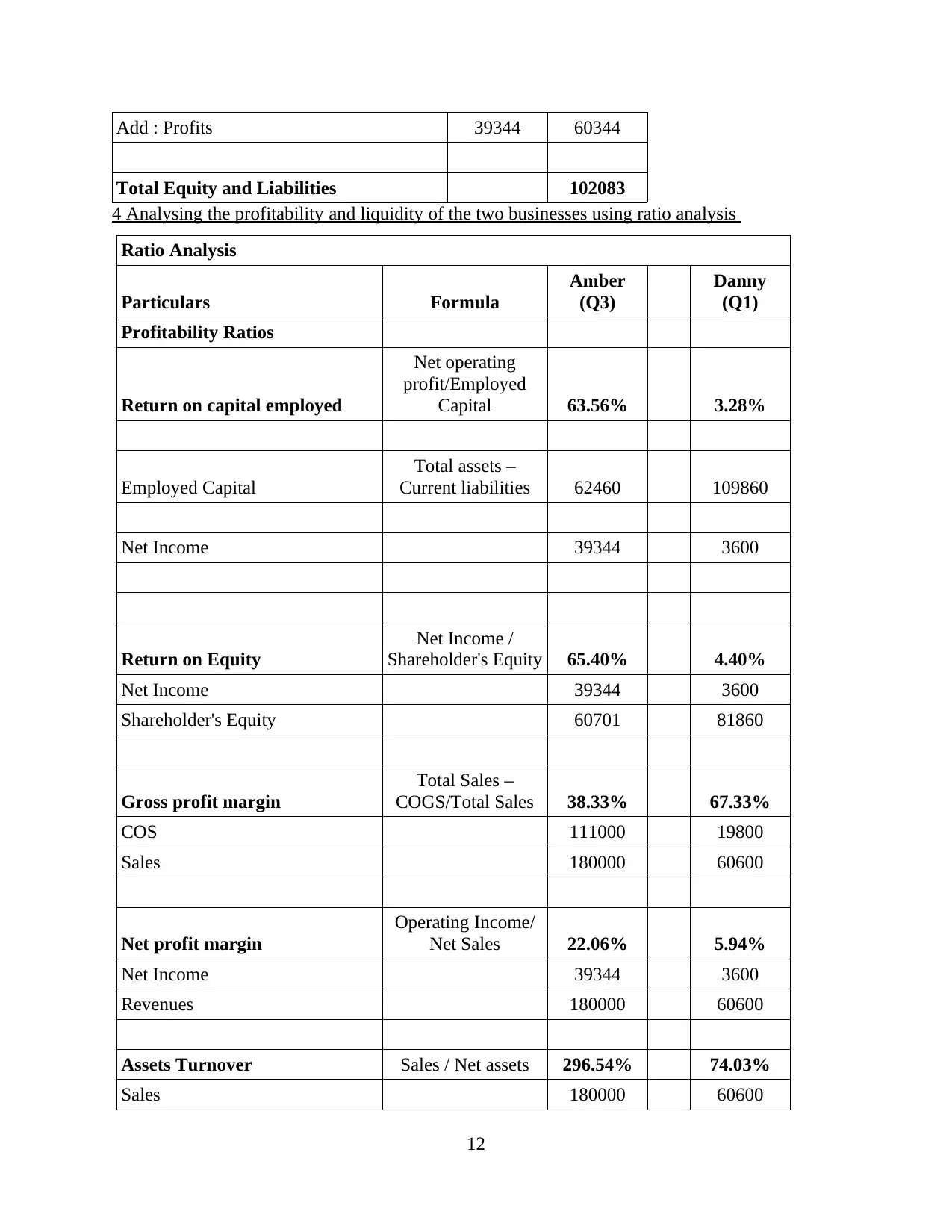
Add : Profits 39344 60344
Total Equity and Liabilities 102083
4 Analysing the profitability and liquidity of the two businesses using ratio analysis
Ratio Analysis
Particulars Formula
Amber
(Q3)
Danny
(Q1)
Profitability Ratios
Return on capital employed
Net operating
profit/Employed
Capital 63.56% 3.28%
Employed Capital
Total assets –
Current liabilities 62460 109860
Net Income 39344 3600
Return on Equity
Net Income /
Shareholder's Equity 65.40% 4.40%
Net Income 39344 3600
Shareholder's Equity 60701 81860
Gross profit margin
Total Sales –
COGS/Total Sales 38.33% 67.33%
COS 111000 19800
Sales 180000 60600
Net profit margin
Operating Income/
Net Sales 22.06% 5.94%
Net Income 39344 3600
Revenues 180000 60600
Assets Turnover Sales / Net assets 296.54% 74.03%
Sales 180000 60600
12
Total Equity and Liabilities 102083
4 Analysing the profitability and liquidity of the two businesses using ratio analysis
Ratio Analysis
Particulars Formula
Amber
(Q3)
Danny
(Q1)
Profitability Ratios
Return on capital employed
Net operating
profit/Employed
Capital 63.56% 3.28%
Employed Capital
Total assets –
Current liabilities 62460 109860
Net Income 39344 3600
Return on Equity
Net Income /
Shareholder's Equity 65.40% 4.40%
Net Income 39344 3600
Shareholder's Equity 60701 81860
Gross profit margin
Total Sales –
COGS/Total Sales 38.33% 67.33%
COS 111000 19800
Sales 180000 60600
Net profit margin
Operating Income/
Net Sales 22.06% 5.94%
Net Income 39344 3600
Revenues 180000 60600
Assets Turnover Sales / Net assets 296.54% 74.03%
Sales 180000 60600
12
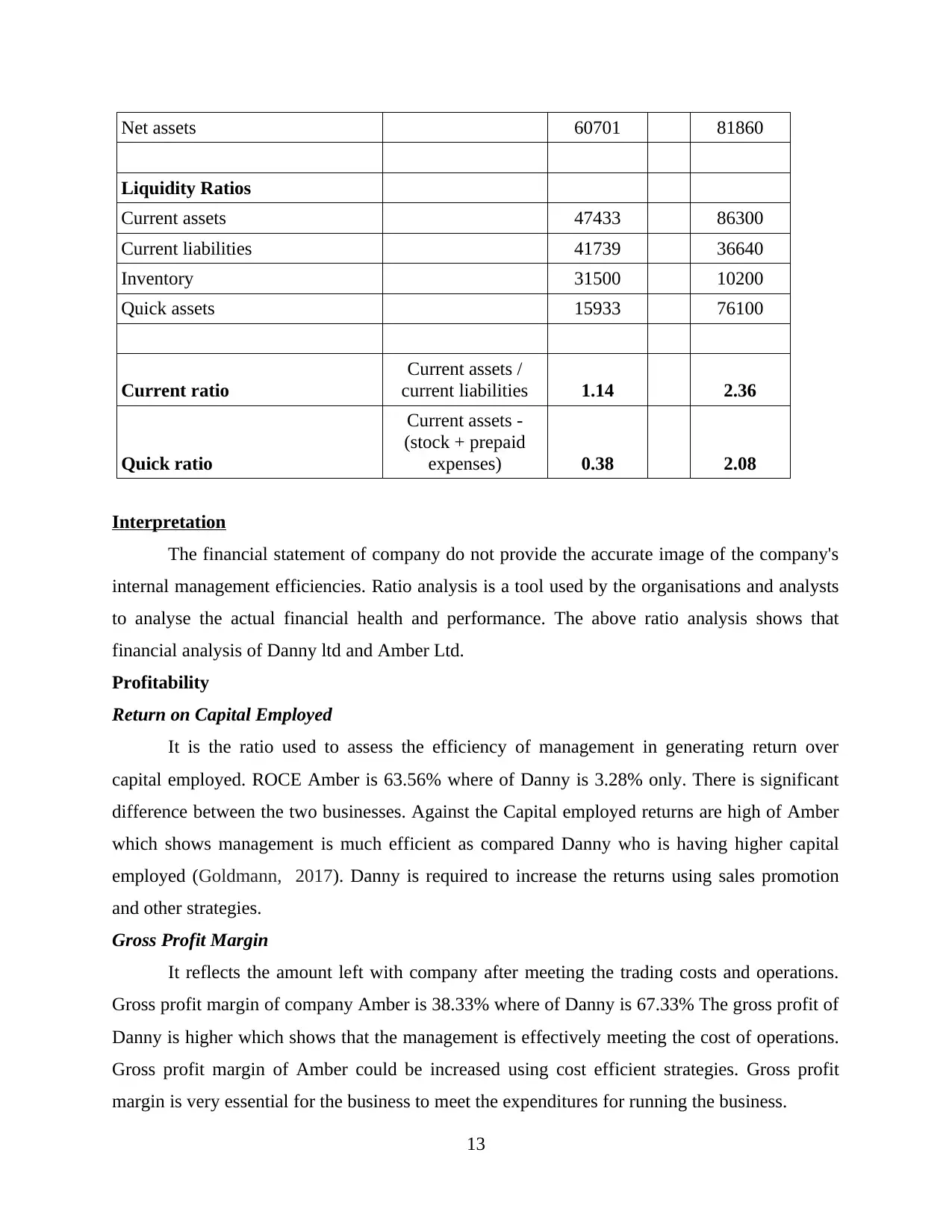
Net assets 60701 81860
Liquidity Ratios
Current assets 47433 86300
Current liabilities 41739 36640
Inventory 31500 10200
Quick assets 15933 76100
Current ratio
Current assets /
current liabilities 1.14 2.36
Quick ratio
Current assets -
(stock + prepaid
expenses) 0.38 2.08
Interpretation
The financial statement of company do not provide the accurate image of the company's
internal management efficiencies. Ratio analysis is a tool used by the organisations and analysts
to analyse the actual financial health and performance. The above ratio analysis shows that
financial analysis of Danny ltd and Amber Ltd.
Profitability
Return on Capital Employed
It is the ratio used to assess the efficiency of management in generating return over
capital employed. ROCE Amber is 63.56% where of Danny is 3.28% only. There is significant
difference between the two businesses. Against the Capital employed returns are high of Amber
which shows management is much efficient as compared Danny who is having higher capital
employed (Goldmann, 2017). Danny is required to increase the returns using sales promotion
and other strategies.
Gross Profit Margin
It reflects the amount left with company after meeting the trading costs and operations.
Gross profit margin of company Amber is 38.33% where of Danny is 67.33% The gross profit of
Danny is higher which shows that the management is effectively meeting the cost of operations.
Gross profit margin of Amber could be increased using cost efficient strategies. Gross profit
margin is very essential for the business to meet the expenditures for running the business.
13
Liquidity Ratios
Current assets 47433 86300
Current liabilities 41739 36640
Inventory 31500 10200
Quick assets 15933 76100
Current ratio
Current assets /
current liabilities 1.14 2.36
Quick ratio
Current assets -
(stock + prepaid
expenses) 0.38 2.08
Interpretation
The financial statement of company do not provide the accurate image of the company's
internal management efficiencies. Ratio analysis is a tool used by the organisations and analysts
to analyse the actual financial health and performance. The above ratio analysis shows that
financial analysis of Danny ltd and Amber Ltd.
Profitability
Return on Capital Employed
It is the ratio used to assess the efficiency of management in generating return over
capital employed. ROCE Amber is 63.56% where of Danny is 3.28% only. There is significant
difference between the two businesses. Against the Capital employed returns are high of Amber
which shows management is much efficient as compared Danny who is having higher capital
employed (Goldmann, 2017). Danny is required to increase the returns using sales promotion
and other strategies.
Gross Profit Margin
It reflects the amount left with company after meeting the trading costs and operations.
Gross profit margin of company Amber is 38.33% where of Danny is 67.33% The gross profit of
Danny is higher which shows that the management is effectively meeting the cost of operations.
Gross profit margin of Amber could be increased using cost efficient strategies. Gross profit
margin is very essential for the business to meet the expenditures for running the business.
13
⊘ This is a preview!⊘
Do you want full access?
Subscribe today to unlock all pages.

Trusted by 1+ million students worldwide

Net profit margin
This ratio is used for assessing the profitability of company. It could be assessed from the
above ratio that Amber is having profit margin of 22.06% and Danny is having profit margin of
5.94% which is very low. Lower net profit have negative impact over the business. It requires the
management to carry out their costs and expenses in the most efficient manner for increasing the
profits. Amber is having higher net profit despite of lower gross profit.
Return on Equity
It could be analysed that ROE of Amber is high from Danny. Higher return reflects that
business has been running efficiently and generating adequate returns from the business (Durrah
and et.al., 2016). The ratio is used by investors to make the investment decisions.
Liquidity
Current Ratio
Ratio is used by the management and investors to assess the ability of company in
meeting the short term obligations. Current ratio is used for analysing the liquidity position of the
company. Current ratio of Amber is 1.14 and of Danny is 2.36. It could be seen that the current
ratio of Danny is adequate as per standards of 2:1. On the other Amber is having weak liquidity
position. Business is required to take measures and steps that are essential for increasing the
liquidity position.
Quick Ratio
It is a ratio used for assessing liquidity excluding the inventories from current assets.
There are various analysts and experts that do not consider inventories as current assets as the
business could not sell them immediately (Janjua and et.al., 2016). Quick ratio of Amber is 0.38
and of Danny is 2.08. It could be evaluated that Amber is having very low liquidity and is not
having enough current assets for meeting the short term liabilities and obligations.
From the financial analysis it could be evaluated that in terms of profitability Amber is
adequate and liquidity of Danny is strong. On overall basis investors will choose to invest in
Amber with high profitability as the liquidity position of the company could be strengthened but
it is hard to increase the profitability to the level of Amber.
14
This ratio is used for assessing the profitability of company. It could be assessed from the
above ratio that Amber is having profit margin of 22.06% and Danny is having profit margin of
5.94% which is very low. Lower net profit have negative impact over the business. It requires the
management to carry out their costs and expenses in the most efficient manner for increasing the
profits. Amber is having higher net profit despite of lower gross profit.
Return on Equity
It could be analysed that ROE of Amber is high from Danny. Higher return reflects that
business has been running efficiently and generating adequate returns from the business (Durrah
and et.al., 2016). The ratio is used by investors to make the investment decisions.
Liquidity
Current Ratio
Ratio is used by the management and investors to assess the ability of company in
meeting the short term obligations. Current ratio is used for analysing the liquidity position of the
company. Current ratio of Amber is 1.14 and of Danny is 2.36. It could be seen that the current
ratio of Danny is adequate as per standards of 2:1. On the other Amber is having weak liquidity
position. Business is required to take measures and steps that are essential for increasing the
liquidity position.
Quick Ratio
It is a ratio used for assessing liquidity excluding the inventories from current assets.
There are various analysts and experts that do not consider inventories as current assets as the
business could not sell them immediately (Janjua and et.al., 2016). Quick ratio of Amber is 0.38
and of Danny is 2.08. It could be evaluated that Amber is having very low liquidity and is not
having enough current assets for meeting the short term liabilities and obligations.
From the financial analysis it could be evaluated that in terms of profitability Amber is
adequate and liquidity of Danny is strong. On overall basis investors will choose to invest in
Amber with high profitability as the liquidity position of the company could be strengthened but
it is hard to increase the profitability to the level of Amber.
14
Paraphrase This Document
Need a fresh take? Get an instant paraphrase of this document with our AI Paraphraser

REFERENCES
Books and Journals
BOGHEAN16, F., and et.al., 2019. THE ROLE OF ACCOUNTING IN DECISION MAKING
BY MANAGERS–EMPIRICAL RESEARCH REGARDING THE USE OF FINANCIAL
ACCOUNTING INFORMATION.
Abdullah, M.D.F., Ardiansah, M.N. and Hamidah, N., 2017. The Effect of Company Size,
Company Age, Public Ownership and Audit Quality on Internet Financial
Reporting. Sriwijaya international journal of dynamic economics and business. 1(2).
pp.153-166.
Mabula, J.B. and Dongping, H., 2019. SME managers' financial literacy on firm practices in
Tanzania. International Journal of Knowledge Engineering and Data Mining. 6(4).
pp.376-394.
Goldmann, K., 2017. Financial liquidity and profitability management in practice of polish
business. In Financial Environment and Business Development (pp. 103-112). Springer,
Cham.
Durrah, O., and et.al., 2016. Exploring the relationship between liquidity ratios and indicators of
financial performance: An analytical study on food industrial companies listed in Amman
Bursa. International Journal of Economics and Financial Issues. 6(2).
Janjua, A.R., and et.al., 2016. Influence of Liquidity on Profitability of Cement Sector:
Indication from Firms Listed in Pakistan Stock Exchange. Business Management
Dynamics. 6(5). p.1.
15
Books and Journals
BOGHEAN16, F., and et.al., 2019. THE ROLE OF ACCOUNTING IN DECISION MAKING
BY MANAGERS–EMPIRICAL RESEARCH REGARDING THE USE OF FINANCIAL
ACCOUNTING INFORMATION.
Abdullah, M.D.F., Ardiansah, M.N. and Hamidah, N., 2017. The Effect of Company Size,
Company Age, Public Ownership and Audit Quality on Internet Financial
Reporting. Sriwijaya international journal of dynamic economics and business. 1(2).
pp.153-166.
Mabula, J.B. and Dongping, H., 2019. SME managers' financial literacy on firm practices in
Tanzania. International Journal of Knowledge Engineering and Data Mining. 6(4).
pp.376-394.
Goldmann, K., 2017. Financial liquidity and profitability management in practice of polish
business. In Financial Environment and Business Development (pp. 103-112). Springer,
Cham.
Durrah, O., and et.al., 2016. Exploring the relationship between liquidity ratios and indicators of
financial performance: An analytical study on food industrial companies listed in Amman
Bursa. International Journal of Economics and Financial Issues. 6(2).
Janjua, A.R., and et.al., 2016. Influence of Liquidity on Profitability of Cement Sector:
Indication from Firms Listed in Pakistan Stock Exchange. Business Management
Dynamics. 6(5). p.1.
15
1 out of 17
Related Documents
Your All-in-One AI-Powered Toolkit for Academic Success.
+13062052269
info@desklib.com
Available 24*7 on WhatsApp / Email
![[object Object]](/_next/static/media/star-bottom.7253800d.svg)
Unlock your academic potential
© 2024 | Zucol Services PVT LTD | All rights reserved.





